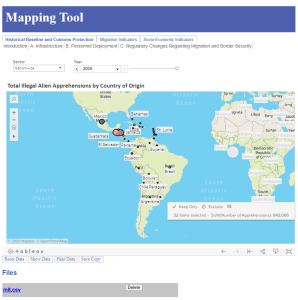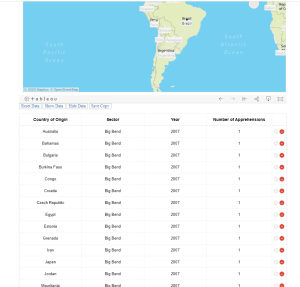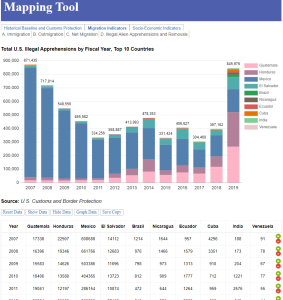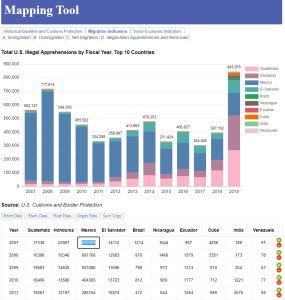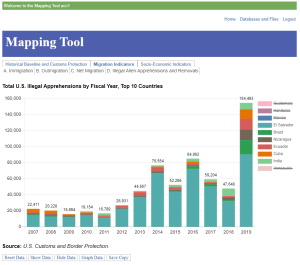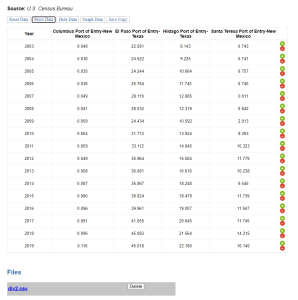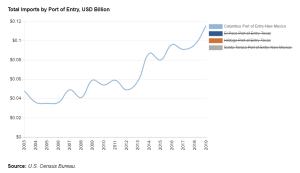
Final Report
The Challenge
Along the U.S.-Mexico border, decades of border security deployments have impacted the communities in the El Paso Sector in a variety of ways. Currently, no comprehensive visualization exists to understand the degree and manner of these impacts in areas such as public safety, public health, and economic growth. The goal of the project was to understand fully and comprehensively the impact of border security deployments, i.e., infrastructure and personnel, and the related policy changes, on socio-economic indices in the El Paso Sector. Without such comprehensive mapping, uncertainty and risk would impinge upon future operations, resource deployment, and risk-mitigation strategies.
The Proposed Solution
The proposed impact mapping would then have a tactical value. The 2020 Strategic Plan for Customs and Border Protection (CBP) states that in order to optimize the impact of its limited resources, e.g., personnel, technology, and infrastructure, on mission outcomes, CBP, and by extension, USBP, will utilize a risk-management strategy. This risk-management strategy prioritizes areas that pose a high-risk threat while CBP’s strategic resource management framework informs decision makers on the optimal combination of resources to address high-risk areas.
Based on discussions with USBP, its current strategic resource management framework would be strengthened by having information related to the impact that border security has had on border communities using historical mapping of resource deployments and regulations against social, demographic, and economic indicators. By leveraging additional data indicators to improve situational awareness, CBP and USBP will be able to build a comprehensive profile of the value and effectiveness of resource deployment.
Furthermore, the data used to build the tactical mapping will also inform the future border security deployments to maximize the return on investment based on estimates of economic impact using the IMPLAN model.
With these two resources at its disposal, i.e. the comprehensive tactical mapping of past border security impacts and the economic impact modeling of future security deployments, CBP and USBP will be able to respond with greater efficiency and certainty and optimize its risk mitigation efforts.
The Process
The Hunt Institute will generate the tactical mapping by using data visualization software (e.g., Tableau) to display a series of historical social and economic data against past border security deployments. The social and economic data will be collected from U.S. government databases, such as the Department of Homeland Security, the U.S. Census Bureau, the Bureau of Economic Analysis, the Bureau of Labor Statistics, the Federal Deposit Insurance Corporation, the Financial Crimes Enforcement Network, the U.S. Department of Health, the Federal Bureau of Investigation, the U.S. Department of Health, and the Centers for Disease Control, as well as from state government databases in New Mexico and Texas. This federal and state data will then be mapped against the border security deployments to generate a historical visualization of how U.S. border communities in the El Paso Sector have been impacted by past border security deployments and regulatory changes concerning immigration and customs enforcement.
For example, a fixed baseline of data regarding past border security deployments (personnel and infrastructure) will serve as the background upon which a variety of historical social and economic data from the communities in the El Paso Sector can be represented simultaneously. The end product will allow for all, multiple, or just one socio-economic data point to be graphed against this baseline of border security deployment data. An added benefit of using the data visualization software allows for the animation of the historical data so that the increase or decrease of impacts can be seen from past to present against the baseline border security deployment data.
The economic impact model will utilize IMPLAN, an Input-Output (I-O), multiplier-based, static system. I-O analysis models how industries are linked by the intermediate inputs they provide one another to produce the final output in a regional economy. IMPLAN gathers data from a large variety of sources to generate I-O multipliers, a measure of how dollars interjected into a region are re-spent, thereby leading to additional economic activity. Given an input, for example, CBP’s or USBP’s expenditures within a region, IMPLAN applies I-O multipliers to estimate the total economic activity generated from CBP’s expenditures. IMPLAN is a static system and the software assumes the estimates are for the same year of the expenditures. IMPLAN cannot forecast economic activity.
The economic impact model will provide three indicators of economic activity across employment, labor income, and output:
- Employment - the average annual full-time jobs within industry sectors. Seasonal jobs are not included.
- Labor Income - the sum value of compensation paid to workers and business proprietors. The value includes wages, salaries, employer-paid benefits, and payroll taxes.
- Output - the value of all goods and services produced within the region's economy.
For each indicator, the impact analysis will provide values for direct, indirect, and induced effects, which sum to equal the indicator value. The value of CBP’s expenditures within the region are the direct effect, representing the initial change in the industry in question; the direct effect causes increased suppliers within the region, the indirect effect, the changes in inter-industry transactions when supplying industries respond to increased demands from the directly affected industries, and the induced effect, the combination of direct and indirect effects cause expenditures by CBP and supplier households within the region.
The Hunt Institute will also collect, house, and access according to a Data Management Plan. The Data Management Plan begins with the type of data to be used in the proposed project. All data used in the proposed tactical mapping and economic impact model will be sourced from official, public sources at the federal level, such as the U.S. Census Bureau, the Bureau of Labor Statistics, the Bureau of Economic Analysis, the Bureau of Transportation Statistics, as well as from state and local level sources. All data utilized will be aggregate, non-identifiable, non-personal data. No personal information whatsoever will be used in this proposed project. All data that is collected will then be organized and stored in excel files according to type to be made available to Customs ad Border Protection for reference or use in future projects, which will be described further in the deliverables.


